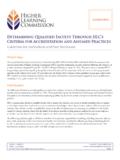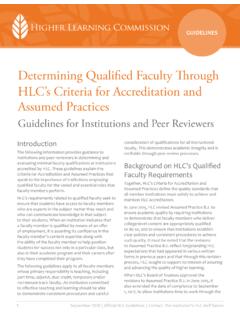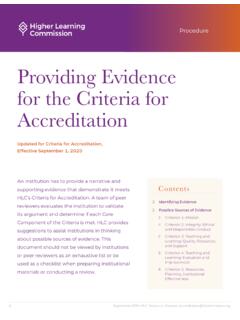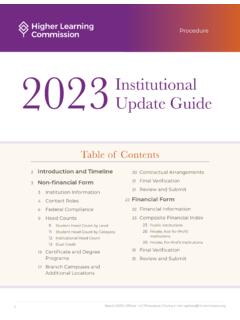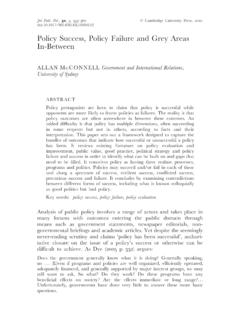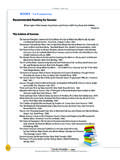Transcription of DEFINING STUDENT SUCCESS DATA RECOMMENDATIONS …
1 DEFINING STUDENT SUCCESS DATA. RECOMMENDATIONS . FOR CHANGING THE. CONVERSATION. Introduction STUDENT SUCCESS is more than a buzzword. It is a driving force behind policy and institutional change efforts underway in postsecondary education. Ewell and Wellman (2007) state that in its simplest form, STUDENT SUCCESS can be understood as getting students into and through college to a degree or certificate (p. 2). As a movement, STUDENT SUCCESS has become intricately linked with the completion agenda, emerging from concerns regarding the falling behind in degree attainment internationally, issues of institutional funding and rising STUDENT debt, increasing numbers of students leaving with debt and no credentials, and ongoing employer needs to find qualified workers. Completion is the word of the day, with persistence, motivations of both the students and the faculty.
2 The retention, graduation and job placement rates of first-time, measures used to determine STUDENT SUCCESS differ with full-time students data leading the conversation. Initiatives the perspective, as do the methods used to help students abound to address the achievement gap between those who reach attainment measures. Add to that, SUCCESS may complete a credential in a timely fashion and those who well be defined differently by students, administrators, do not. Further, the completion agenda has been bolstered and policy makers. Further, a variety of institutions have by national calls from policy makers and foundations alike stated that the measures used in the completion agenda to raise the overall rate of degree attainment (Lumina do not address or capture the majority of students who Foundation, 2017a; Fry, 2017; Obama, 2009).
3 As enter their doors and that institutions are being held Karen Stout, President of Achieving the Dream states, accountable for measures that do not align with their Completion. It's a word that's used a lot when people mission or their STUDENT population. discuss STUDENT SUCCESS (Nazerian, 2018). Institutions have responded to concerns around STUDENT Yet, there are debates among those with a seemingly SUCCESS as tied to completion through increasing attention shared agenda around completion. As Randy Stiles and on teaching and learning, adding support structures co-authors (2018) state, there is evolving thinking about and resources to assist students along the path to the meaning of STUDENT SUCCESS . While persistence and completion, and disaggregating data to better understand completion rates are important and easily measured the needs and educational paths of students served.
4 Yet, outcomes for colleges and universities, these statistics are institutions and systems, as well as SUCCESS measures, are strongly related to the institutional mission and resources, not built for the students of today or how they interact the demographics of the STUDENT body, and the lives and with postsecondary education as opposed to individual 01 Prepared by: HLC's DEFINING STUDENT SUCCESS Data Initiative with funding from Lumina Foundation, December 2018. institutions. While some efforts have emerged to provide definitions of SUCCESS differ from the institution. The better measures of completion, such as the work of the Community College Libraries & Academic Support for STUDENT Achievement Measure (SAM), which tracks STUDENT SUCCESS (CCLASSS) project examined STUDENT STUDENT movement across institutions to provide a more goals, challenges, and needs from the STUDENT perspective.
5 Complete picture of STUDENT progress and completion In spring 2018, they conducted semi-structured within postsecondary education, what is needed is a interviews with students at seven partner community different conversation and examination of STUDENT SUCCESS colleges on STUDENT objectives and goals, definitions of for today's learners. SUCCESS , challenges faced, and coursework practices. The key findings included that students viewed community Who Are Today's Learners? colleges as places that fit their complex lives and needs, The learners of today are diverse and engage with the that students held complex definitions of SUCCESS postsecondary system in a fluid manner. They are not including both career and completion goals as well as just going to college, but working, raising families, and personal growth and development goals, yet they also engaging with their communities.
6 The American Council faced significant challenges related to balancing work, on Education states that post-traditional learners represent finances, school, childcare, transportation, and navigation as much as 60% of enrolled undergraduates, experiencing of resources and services (Wolff-Eisenberg & Braddlee, issues with child care, financial aid, and suboptimal 2018, p. 3). The students of today encounter multiple transfer pathways (Soares, Gagliardi, & Nellum, 2017). barriers at once, experience apprehension in asking for They also enroll at multiple institutions, engaging with help and/or are unaware of available resources. the system, not a single institution. The Department Where students struggled the most was related to of Education (2017) reports a higher number, stating that balancing competing interests such as balancing work 74% of all undergraduates have at least one non-traditional and school, finances, childcare arrangements, adjusting characteristic; 66% transfer between institutions; and 63% to a new language, transportation to and from the are first generation.
7 College, and navigating resources and services at the A Lumina Foundation report (2017b) on today's students, college. Due to working multiple jobs, students found it states that 18- to 21-year-olds make up just one third of difficult to schedule appointments with advisors, testing the college population, that 40% of students attend class centers, and other offices on campus (Wolff-Eisenberg part time, and that almost half are financially on their & Braddlee, 2018). own and/or struggling to make ends meet, with 42% of In such a complex landscape of competing first-year students living near or below the poverty line. priorities, STUDENT SUCCESS is not just about In a 2017 survey of more than 33,000 students, half of getting students to and through, but community college students reported housing insecurity about redesigning institutions to support and two in three students were food insecure (Wolff- Eisenberg & Braddlee, 2018).
8 Research by the Office of students in the complex interplay of their Community College Research and Leadership (Owens, lived experience. Thrill, & Rockey, 2017) states that community college Yet, the data on progression of students through college students represent 45% of all learners, and more than half and their financial or employment condition after leaving of Native American, Hispanic, and Black students enrolled does not directly address the barriers and/or priorities in postsecondary studies. Right now, 60% need at least one that college STUDENT 's value ( STUDENT Connections, developmental course and they lack knowledge on how to 2017a). In essence, offering resources does not mean that navigate college successfully. The students of today balance students are supported. The support needs to be available a complex set of responsibilities and require more flexible to them when they need it, in the form they need it, and course offerings.
9 Not based on institutional convenience. All to say, the learners of today are far So how do today's students view SUCCESS ? They have from the STUDENT population for whom the multiple goals that change and shift at different times. At institutions were designed decades ago. some times they are focused on career and/or educational achievement including getting good grades, obtaining a Navigating institutions not designed for their SUCCESS degree, achieving financial security, and advancing within has proved difficult for learners, especially when their careers. They may start at one institution with certain 02 Prepared by: HLC's DEFINING STUDENT SUCCESS Data Initiative with funding from Lumina Foundation, December 2018. intents and move to another with different goals. But has part because most of their students are working adults and higher education served them well within a SUCCESS as not first-time, full-time students.
10 For competency-based completion conversation? education programs, there are no widely accepted metrics of progress and most have reverted to cross-walking to What Are the Implications of the credit hours and alternative conceptions of retention (Parsons & Rivers, 2017) despite arguments that STUDENT Completion Agenda to the Current learning itself can serve that purpose (Johnstone, Ewell, Conversation on STUDENT SUCCESS ? Paulson, 2010). The current conversation around STUDENT SUCCESS as A report by Civitas Learning (2018) reminds us that in completion has privileged certain types of learners the metrics used to examine STUDENT SUCCESS , the vast and behavioral norms for what a good STUDENT does. majority of efforts are focused on the first-year students This leads to institutional responses that are at times with few resources targeted to those near graduation.
